In-depth review When Rolex was the King of ‘Sports Elegance’-Part 3
Fine WatchesCollector's InsightBlack lacquer dials in early 1950s Rolex watches
Readers of my blog will know that I love black dials in gold watches, be it in chronographs or time only. There is undoubtedly something very striking about a black dial in a gold cased watch.
Not only is the contrast in color very appealing, but black dials in gold cases add a level of sportiness to the watch. The collectability increases of-course, if you are not only talking about a black dial, but rather a black lacquer dial. These, are particularly sought after by collectors, for their mirror type shine and when put in a gold case the contrast is simply striking!
Rolex was competing against time only watches from Vacheron and Patek Philippe, AP, Longines and Eterna (among other brands) in my opinion when they released all these models in the early 1950’s. Why? All are gold models, designed for the connoisseur who wanted something more exclusive than a normal steel watch. These watches are elegant, have relatively large cases (mostly 35/36mm) and have often elegant bracelets that accompany the watch.
For the most part Rolex had the market to themselves as the cases were water-resistant (oyster cases) and the perpetual rotor ensured continuous watch keeping without needing to wind the watch. First in 1953 with Patek and their 2526 did Rolex face any serious competition in the sportive elegance area.
Again, like in the first post about explorer & star dials, & the second about Enamel dials, this post intends to show Rolex and how with these models – it dominated an area I have termed ‘sports elegance’.
Let’s get started.
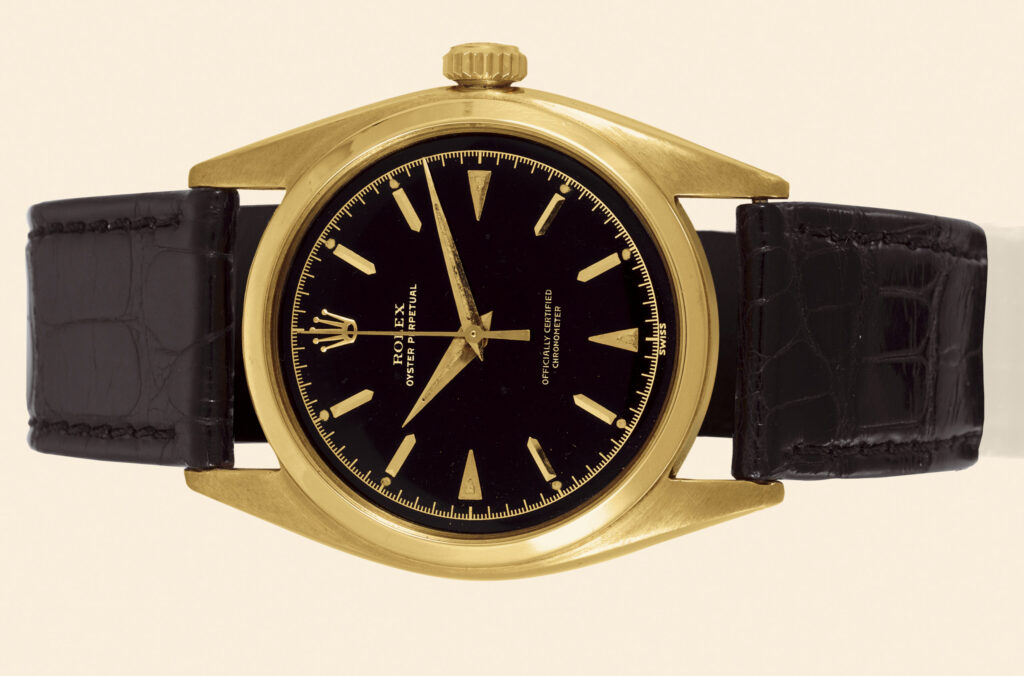
(A fine 1951 Rolex 6098 with full case and nice black lacquer dial and gilt outer minute track).
In my personal view these black lacquer models like 6085, 6098, 6100, 6285 or 6565 and 6298 I show below, play an important role in Rolex history. Why?
I think Rolex used black lacquer dials in these watches as a kind of precursor to what would come in the sports models later on. Early submariners and big crown submariners had black lacquer, often glossy dials, and these gold oyster perpetuals I am going to show remind me of the sportswatches Rolex would make a few years later. While not as glossy the early submariner dials, the resemblance of these black lacquer dials in sports elegance to those in sportswatches is remarkable – as you will see later.
Also this represents a unique period where Rolex was targeting a completely different market than only sports watch buyers. They would change this right after this period and by 1955 were already a different animal than in the early 1950’s. It is fascinating to study this Sports Elegance period by Rolex.
Why don’t we dive into specific models.
We start with 4 watches of the same reference: First a fantastic 6285 in pink gold oyster perpetual. An early 1951 version, which is being sold by Monaco Legend Group next month.
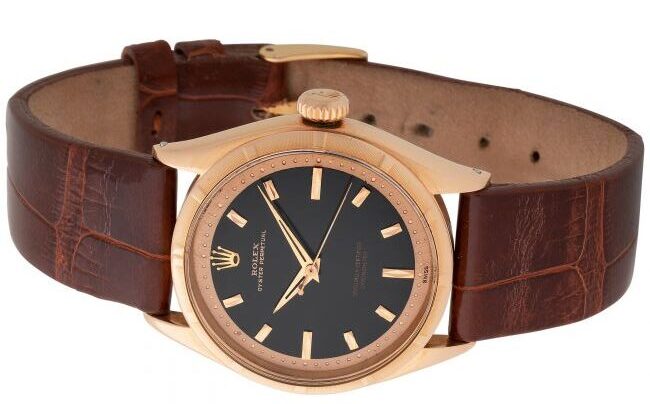
(Monaco Legend Group).
Below the same watch in natural sunlight – exposing the gilt lettering ‘Oyster Perpetual‘ on the dial against the black lacquer dial – a nice contrast!
Notice also the engine turned bezel found on many of these early 1950s Rolex watches in gold.
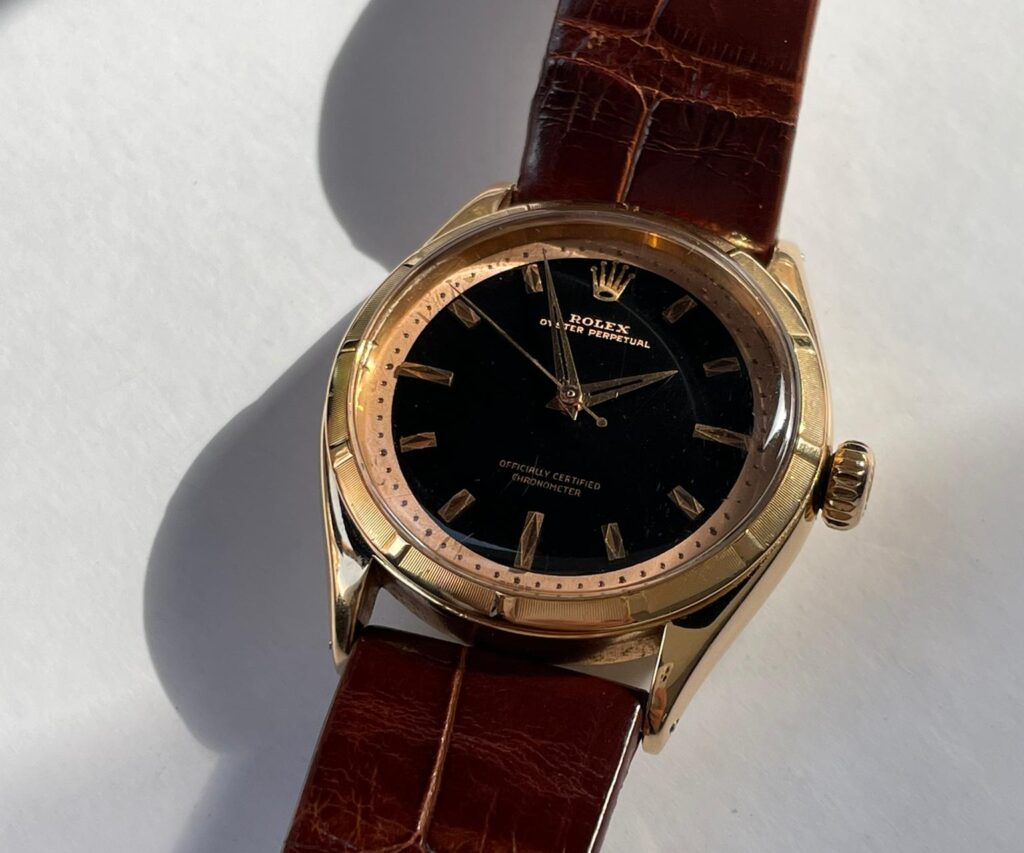
(Andre Parmegiani / Monacolegendgroup).
The second watch, also ref 6285, is this black lacquer gilt dial in a large case (36mm) but in yellow gold.
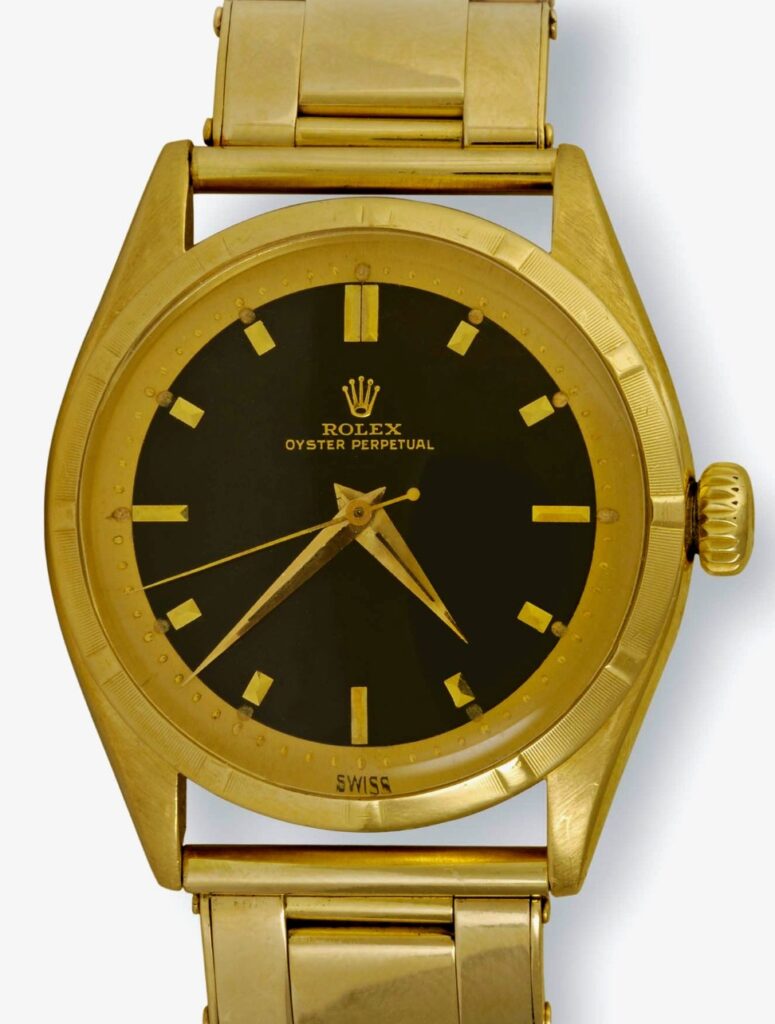
(Credit: Goldberger).
A closer look at the dial below. Superb!
The serial nr of this watch is 963’xxx. Due to the serial number, I assume also a 1951 model. It can be found in the John Goldberger Rolex 100 app or book.
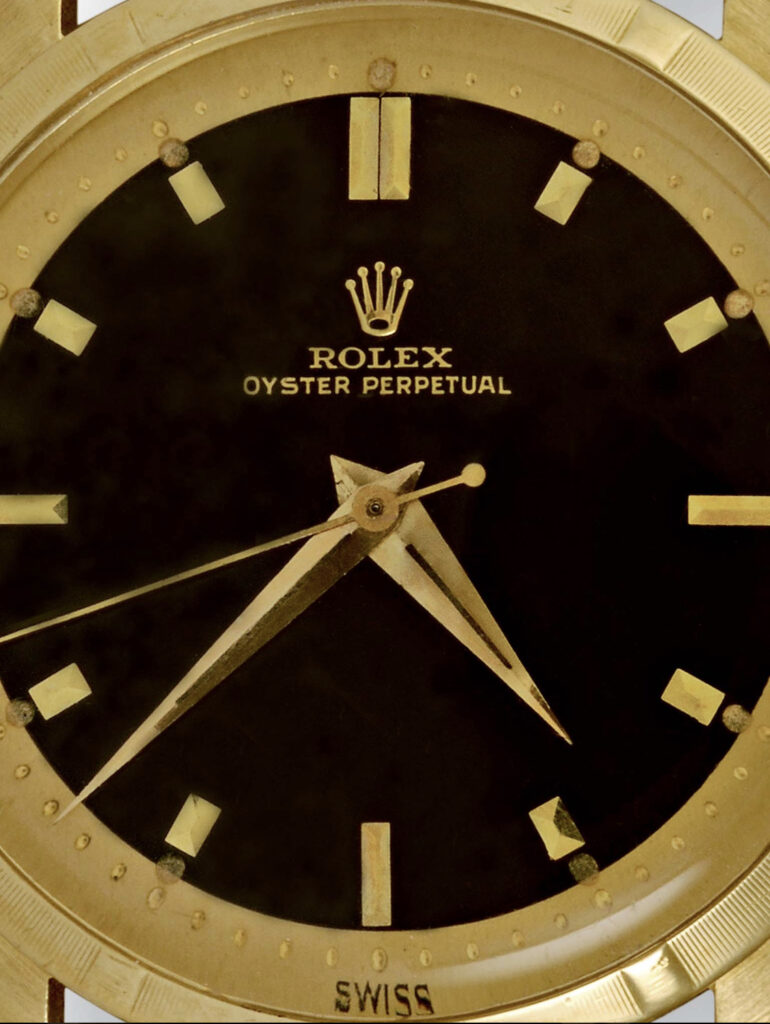
(Credit: Goldberger).
Next ref 6285 I show is a later one.
A mid 1950’s watch (so rather late 6285) with Serial Nr 47’90x (remember Rolex re-set the serial numbers sometime in 1955 thus the 5 digit serial versus the 6 digits for the other 6285 I show). Observe also the rather unusual bezel that is very seldom seen on these large bubbleback watches. It remains the only watch with this unusual bezel I have ever seen in all my research.
Actually, references ending with a ‘5’ especially 6085 and 6285 – all, without exception, have engined turned bezels.
This watch stands out due to the very rare pink gold, so called tile bracelet dated 1955.
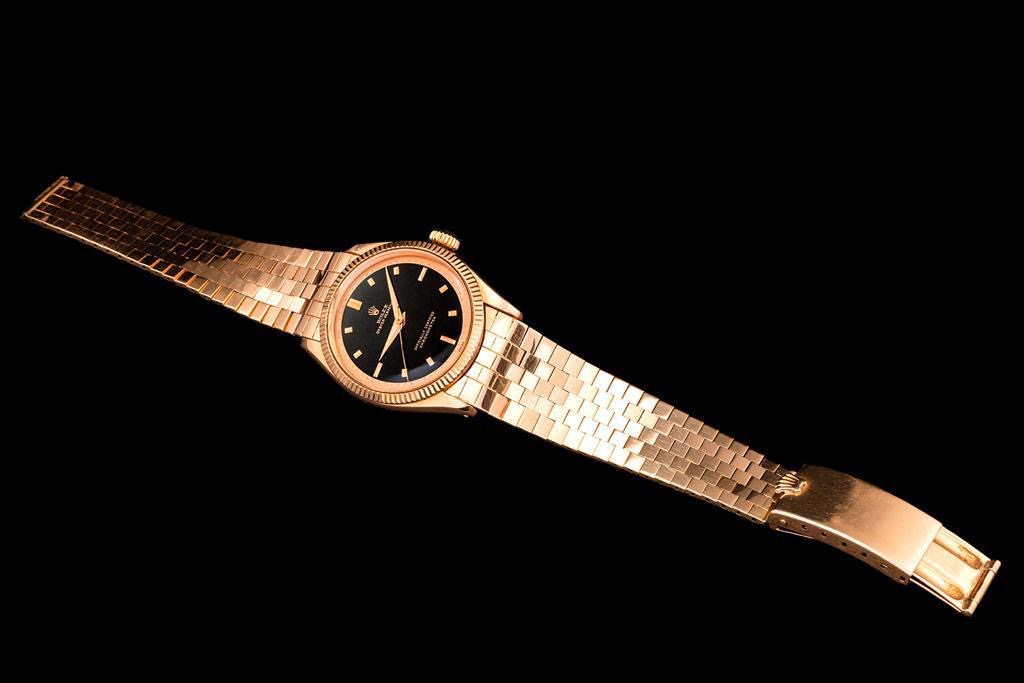
(Credit: mfc.vintagewatches & Roberto Randazzo)
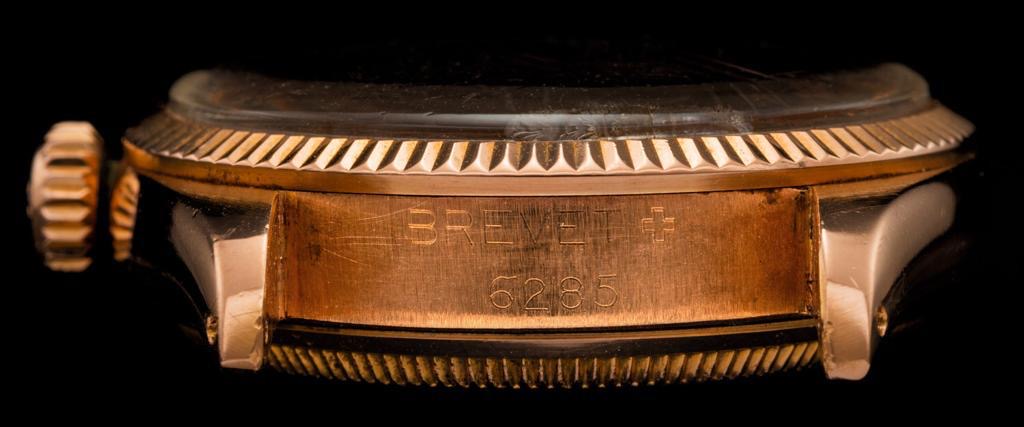
(‘Brevet’ was often seen in these early 1950s watches. Also in the sports watches that would come out at the same time).
The next 6285 is truly amazing! So unusual and very special:
A very fine Rolex ref 6285 with unusual black lacquer dial – owned by a private collector in the Parma region. Until earlier this month – I had never seen such a dial before.
Notice the beautiful tile bracelet. Serial Nr is 93’77x. Here a wristshot of the owner wearing this incredible unusual watch.
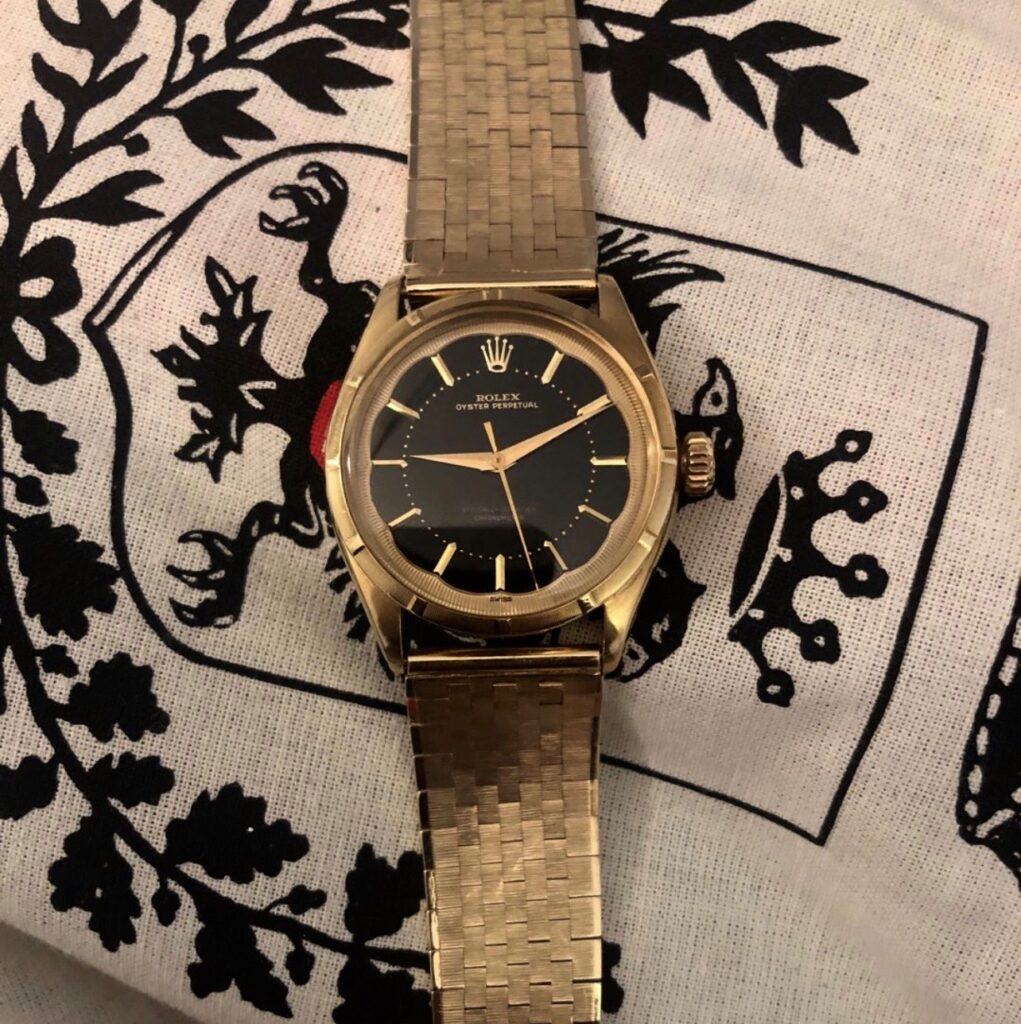
Studying these four different dials all in a 6285 by Rolex is a good exercise in understanding the details of Rolex and ref 6285.
Each has a different dial layout. Some with lume, some without. Same with minute dot markers (first two watches), others without (last two watches). You could argue Rolex was at their peak in terms of artistic know-how – making slight variations to their dials.
All are unique and beautiful!
Let us move on to another reference – also an elusive one. Ever heard of the ref 6100 by Rolex? If not – you should start paying attention to it.
Many beautiful Rolex watches carry this reference. For example, Enamel dials with motifs carry the 6100, as do single uni-color Enamel dials – which we covered in Part 2. Rolex also made a 6100 with black lacquer dial.
Below a fine and early 1950’s Rolex Ref 6100 in pink gold with black lacquer dial. This time the bezel is the smooth version unlike the watch above.
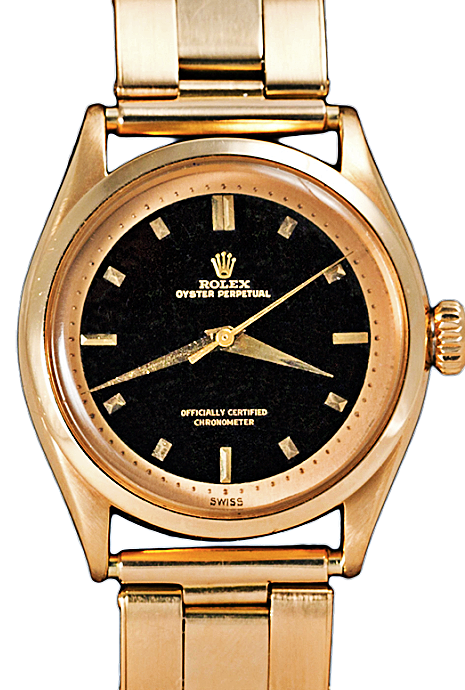
(Credit: Davide Parmegiani).
The ref 6100 has a relatively large case size at 36mm and thus has large presence on the wrist. The watch is currently with the international ‘super dealer’ and now auctioneer Davide Parmegiani. Serial is 975 xxx.
The next reference by Rolex is fairly common, it is ref 6565.
The 6565 is a somewhat small watch at 34mm and was often used by corporations to give it’s most loyal employees (Coca-Cola for example). Even if the 6565 were made in many examples – those in pink gold with black lacquer dial are extremely rare. Below a 1955 Rolex 6565 in pink gold, with nice black lacquer dial with radium lume on the hour markers and hands. Notice the unusual triangle hour markers too.
It sold at Phillips watches for CHF 27’500, higher than even the high estimate.
Again the principle reamins the same. Oyster case, automatic perpetual movement and elegant dial. Serial Nr 831 xxx. The gilt signature shining through perfectly below and the color of the pink gold case basking in the sun.
One of the best black lacquer dials I have seen (and I happily admit I am the proud lucky custodian of this watch).
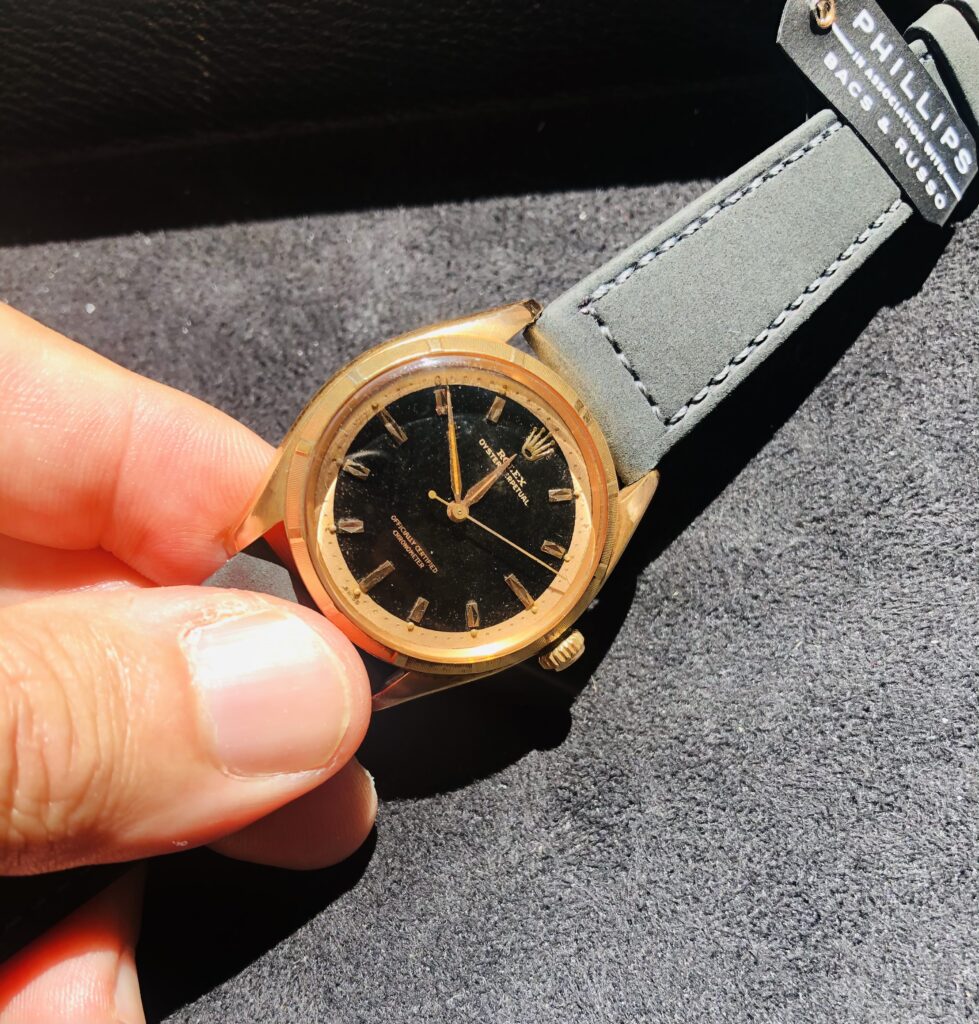
Another fine ref 6098 with black dial was sold by Phillips watches in 2016.
A 1951 6098 with serial Nr 723xxx. Phillips correctly points out the oversize case of 36mm known as the large bubble back, that was mostly found in steel. Notice the gilt (golden) outer minute track against the black lacquer dial. As I would have expected, this watch sold for even higher than the high estimate back in 2016.
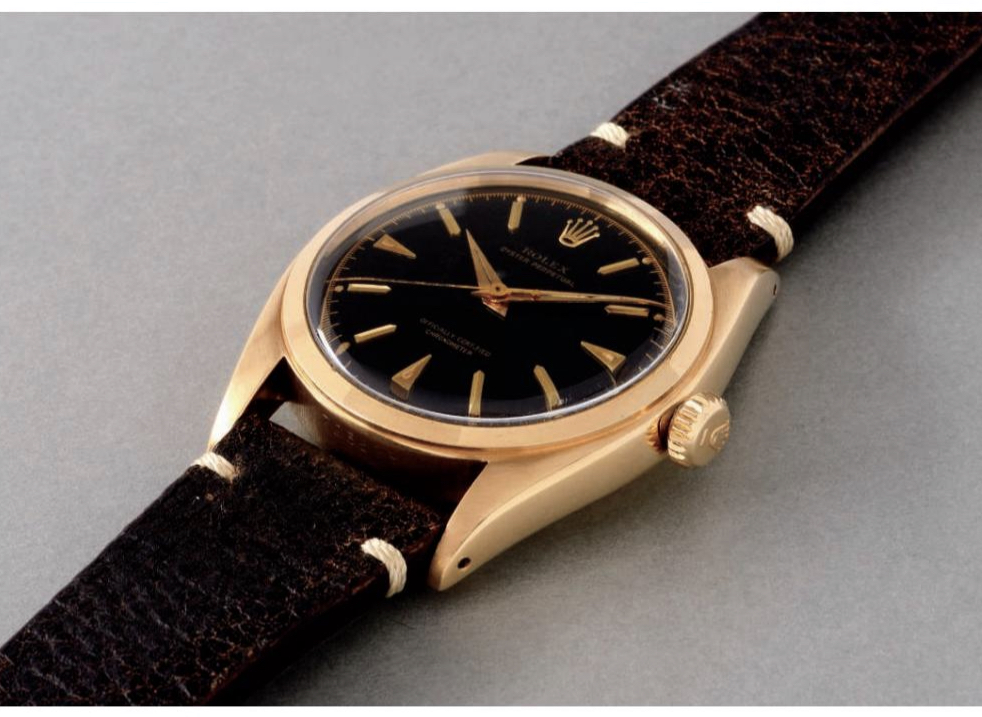
(Credit: Phillips watches).
Below the movement with rotor, ensuring a perpetual functioning for the owner. We are talking 1951, when Rolex offered the best option for gold watches with automatic movement.
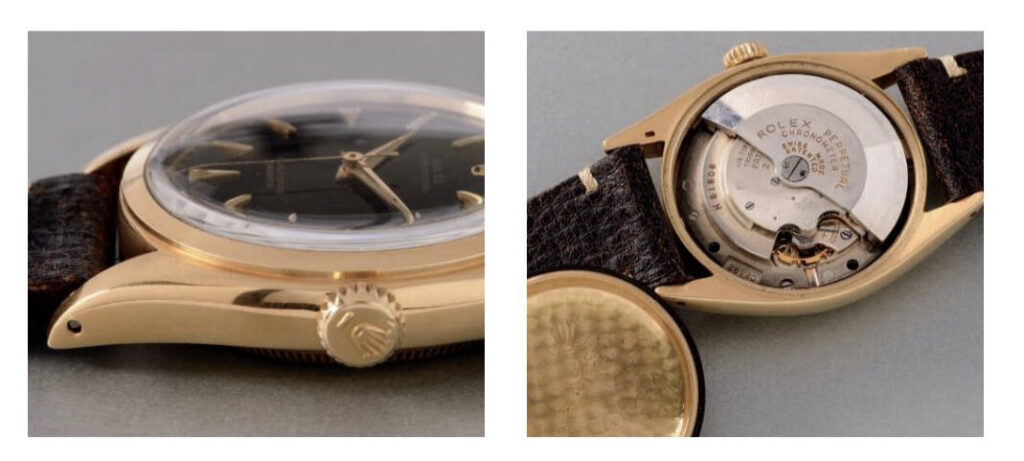
(Credit: Phillips watches).
Now we show something that is very seldom seen: A black lacquer dial 1949 Rolex Ref 5018 with so called Bombay or bombe style case.
What is most interesting- is that the case strongly resembles that of a ref 6090 Bombe style case. As far as I know, it is the only known black-lacquer dial that is seen with this playful case that has been sold by Rolex. It, obviously, sold higher than the high estimate of CHF 24’000 back in 2010.
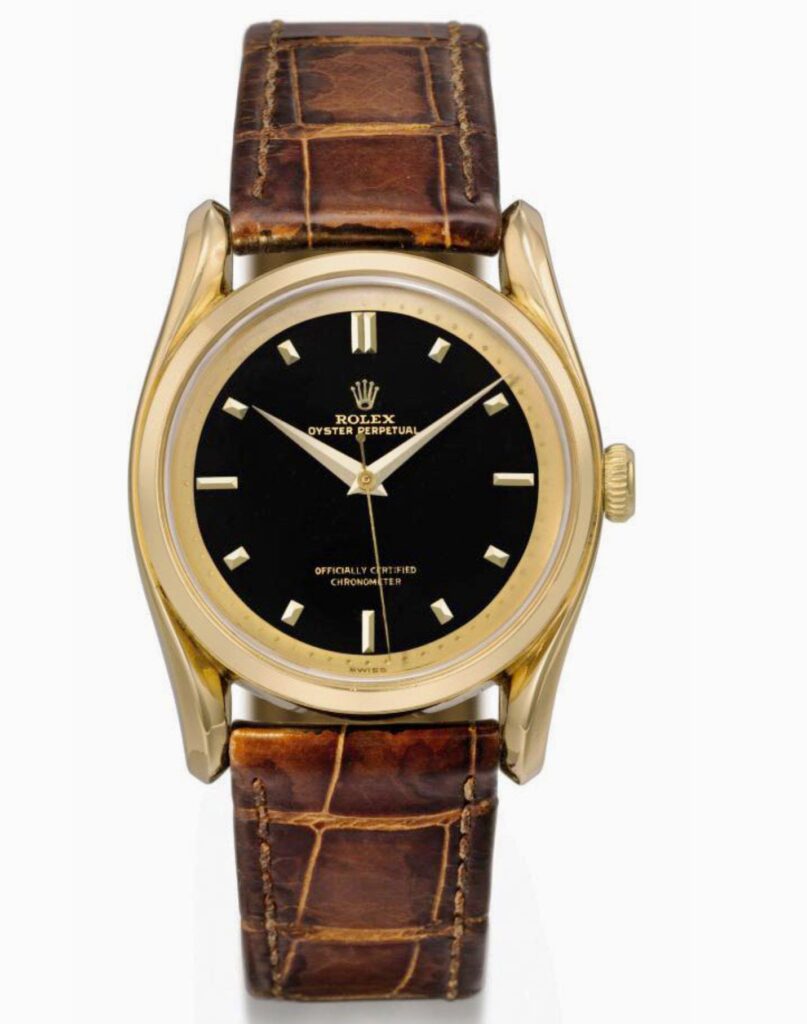
(Credit: Christies watches).
Staying with the Bombay style case, I also have to include the star dials, that are a firm part of Rolex elegance in the 1950`s.
This wonderful star dial 6090 was sold at Christies in 2013 for a strong CHF 50’000. The dial was supplied by Stern Freres and should have the correct codes on the back.
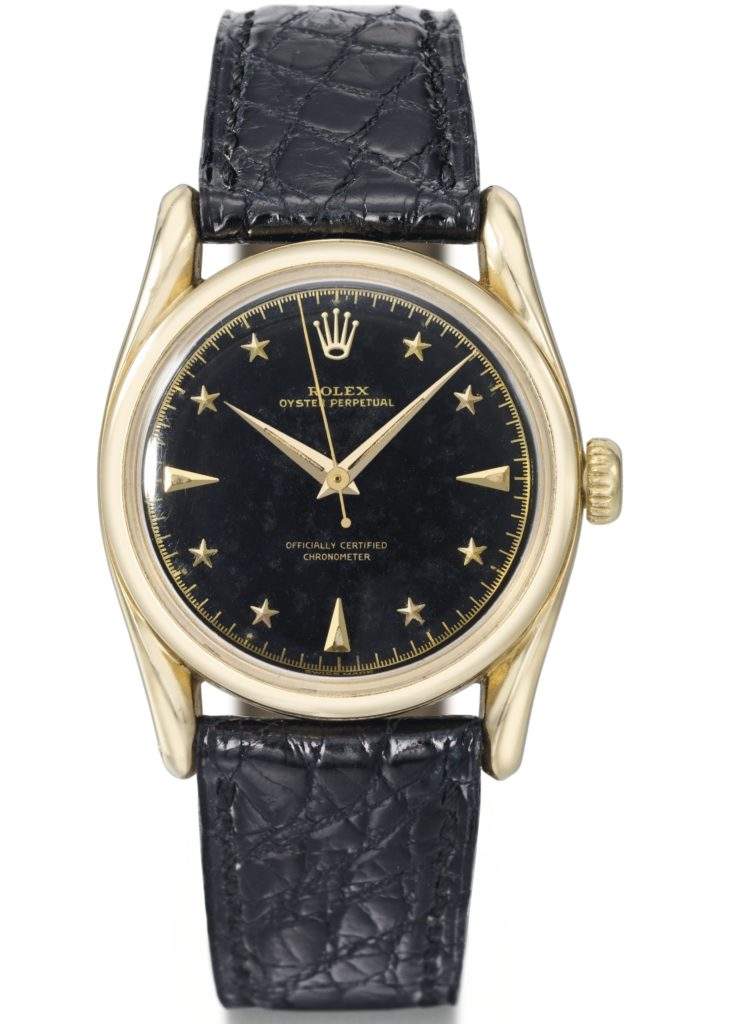
(Credit: Christies watches).
Another -very early Rolex black lacquer dial watch is this 1950 Rolex ref 5028.
Notice the early-type Rolex crown that is also often seen in Rolex watches around 1950 (in Padelone 8171 or other references like the 6285 and 6085 uni-color Enamel dials). This watch has seldom seen hour markers and and a fine gilt outside minute track. Collectors seem to have appreciated this unusual Rolex. Serial Nr 675’xxx.
It sold far above the high estimate of CHF 10-15k to sell for CHF 28’000 back in 2014.

(Credit: Christies watches).
The last watch I would like to show is simply for its very fine apparent condition.
It is also one of the earliest known public sales of a 6098 Rolex with black lacquer dial. It is a 1951 ref 6098 that sold at antiquorum in 2006 and then again in 2007.
Serial Nr 947’xxx. It seems to be in very good condition, and, why the owner decided to sell the watch again 1 year later is a mystery to me. It sold in 2006 for strong money CHF 20’000.

(Credit: Antiquorum).
A close-up of the dial of the exact same watch can be seen here. Super outer gilt minute track.
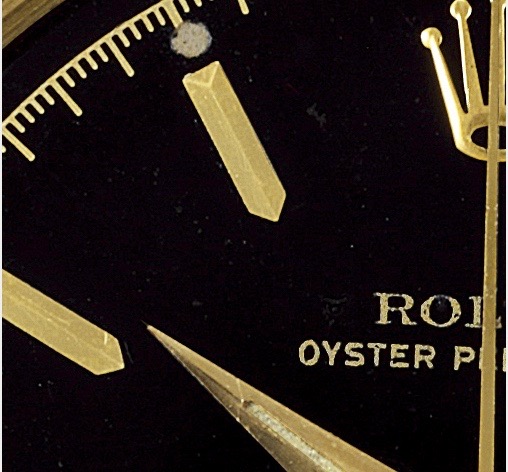
One last comment on black lacquer versus black enamel dials.
With the research I have done and after having talked with some experts, I believe it is unlikely Rolex made black enamel uni-color dials.
Let me state it this way: I have never seen a black Enamel dial for a large bubble back or semi large bubble back. I saw that Christies a few years ago, offered a 6284 with Enamel dial for sale (see below), but I am not sure that ‘Enamel’ is accurate description. It could be, but I am more inclined to think it was black lacquer. Also a recent article in an online watch publication, which I have great respect for, claims Rolex made black Enamel dials and refers to reference numbers 6085, 6100 etc, but when I asked to see evidence, they couldn’t provide it.
I believe that all the black dials found in these large bubble back and semi-bubbleback are black lacquer and not Enamel. I could be mistaken though and would like to see the back of the dial before I can be 100% confident in my claim.
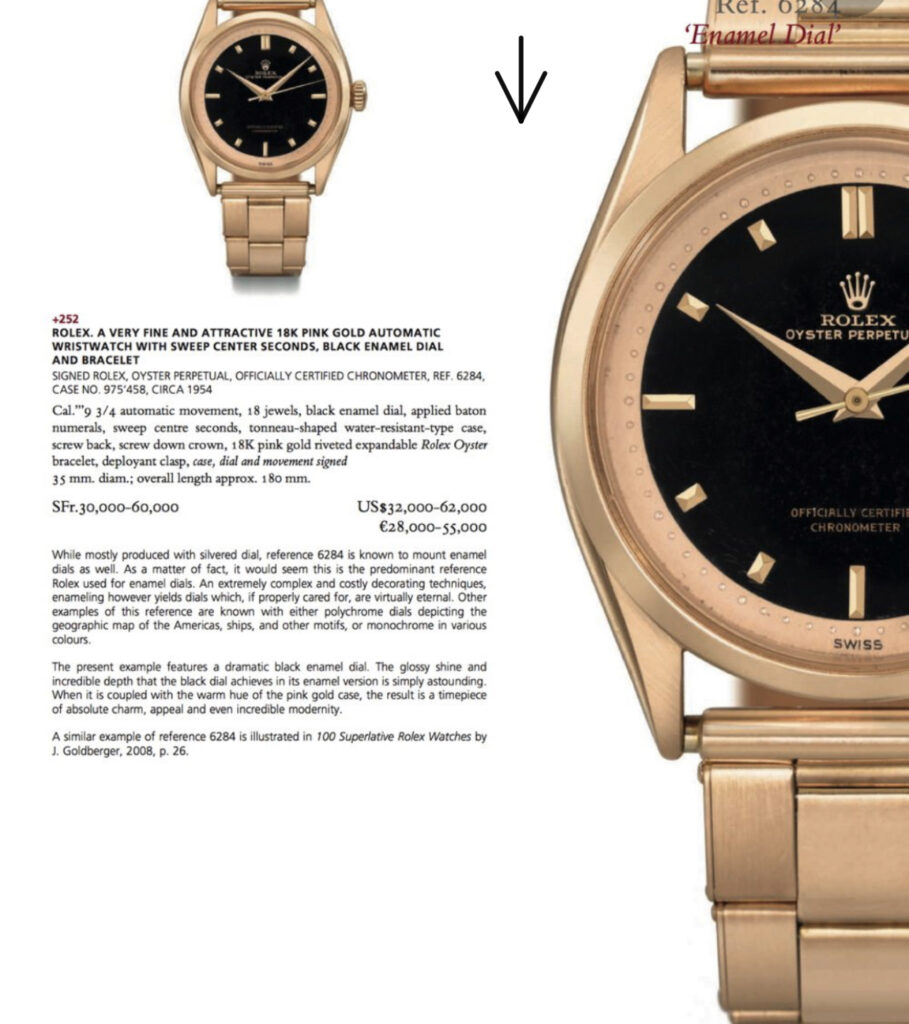
(Credit: Rolexpassion report / Christies).
My last point is the following: In the beginning of the article, I mentioned that these black lacquer dials are similar to the dials of sports watches that Rolex would make just a few years later (in terms of shine). Here is the evidence below. Only 2 years separate both watches (left a 1955 Rolex Ref 6565 and right a 1957 Rolex submariner 6536-1).
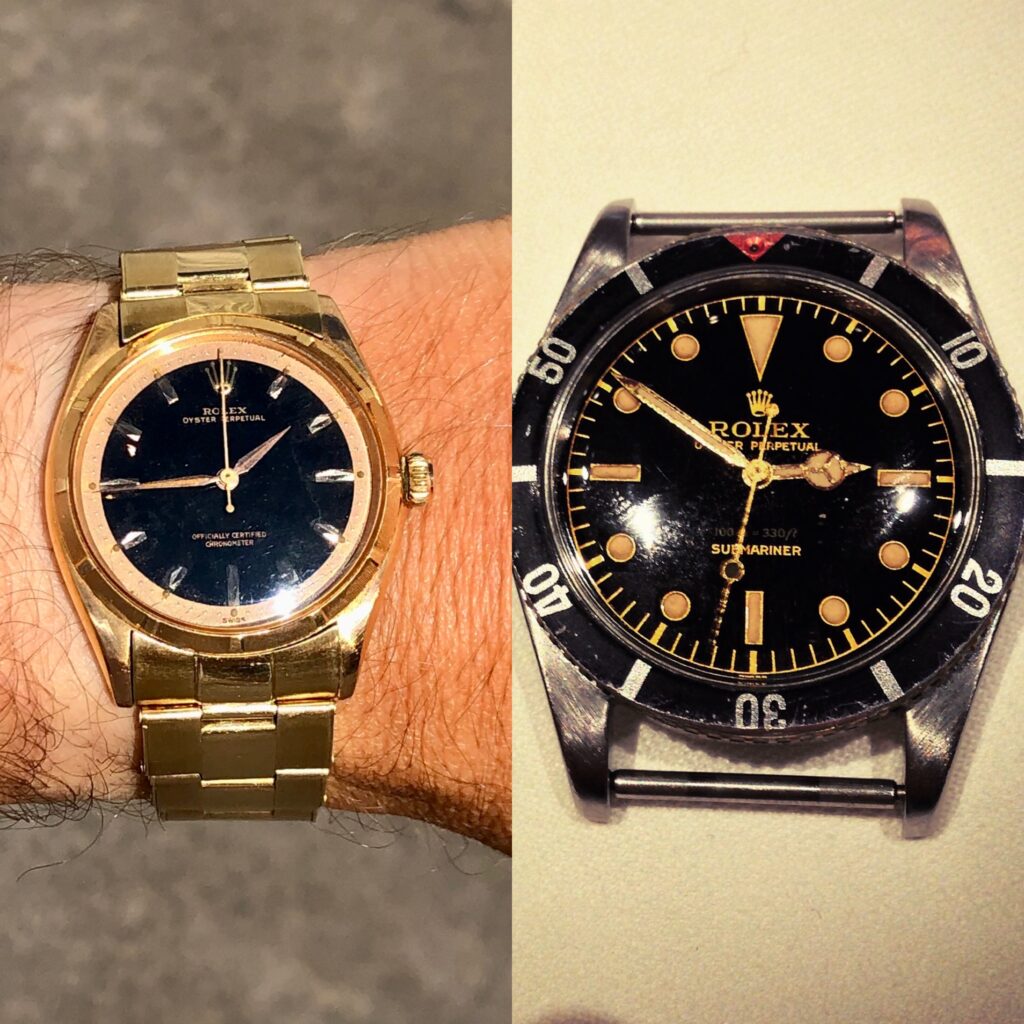
Concluding thoughts
In all the series of sports elegance watches (Explorer & star dials, Enamel dials and black lacquer dials) I wanted to show one thing: Rolex’s incredible capabilities post- war to experiment with a variety of dials and colors in their oyster models with perpetual movements. They created a unique category that I call Sports elegance.
These 3 series of posts was my attempt to illustrate how varied Rolex was, be it in offering explorer honeycomb dials, enamel or black lacquer dials. All three have their charms and in my view represent Rolex at the height of their artistic capabilities. After 1953, Rolex would concentrate and focus more on steel sports watches where they would show large innovations (Submariner 1953, Explorer 53/54 and GMT Master in 1954/5). Tool watches, watches that full-filled a certain purpose, was what Rolex would focus on in the future. They would have tremendous success with it and it is what defines the brand to this day.
For the vintage collector this has an indirect benefit – Rarity. Because of the brief time span of 1949-55 that is the ‘Sports Elegance‘ period, these watches remain some of the most interesting and increasingly sought after models by collectors today.
NB: For full disclosure purposes I have, or might have, a personal interest in one of the watches above in terms of ownership.
Allow me to share some wrist shots of all three series of Rolex and sports elegance. We start with explorer dial below ref 6099.
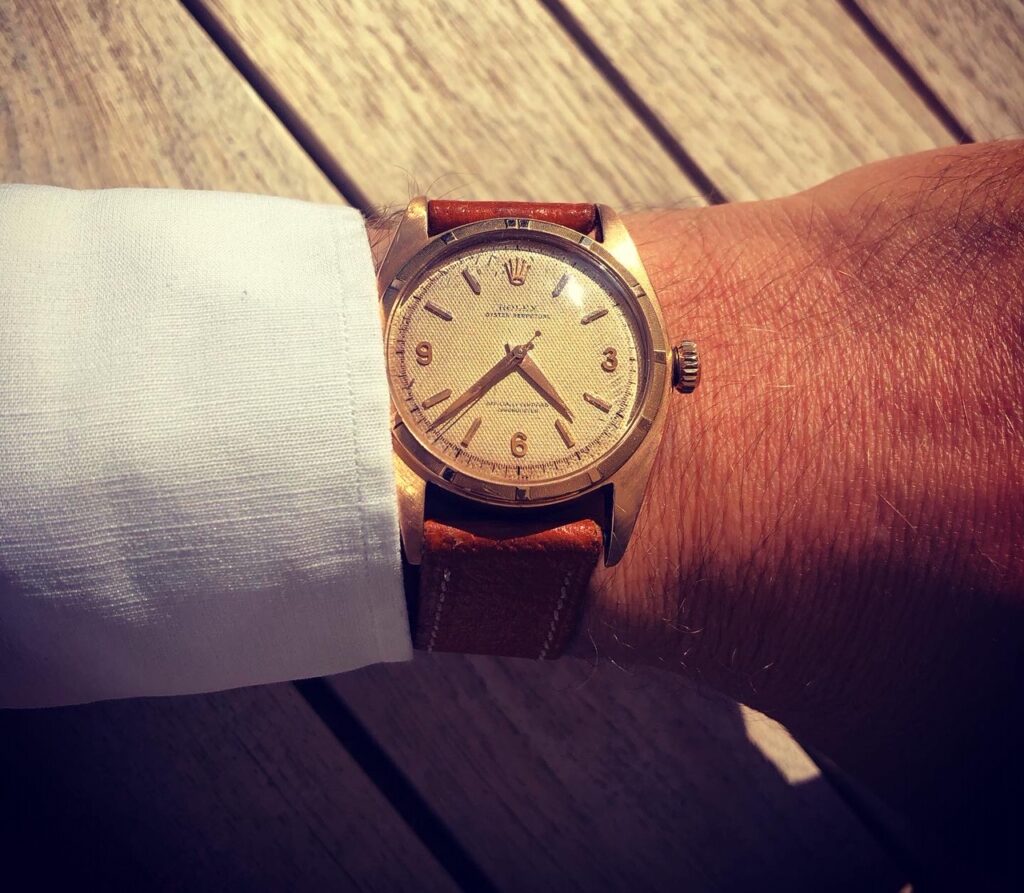
Another honeycomb dial, that is even double signed by Serpico Y Laino coming from an Asian collector. Ref 6098 /6298. Serial Nr on this watch is 739 ‘ xxx.
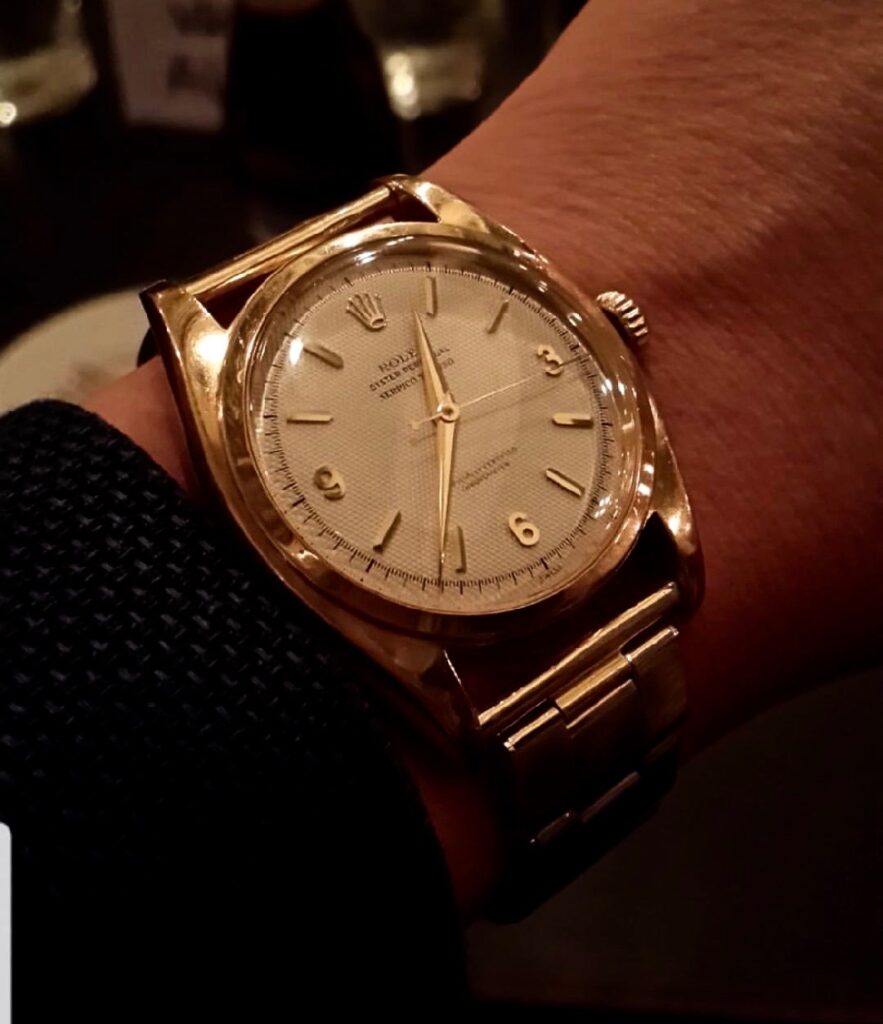
(Credit: Iceman).
Next up the star dial variation of the 6098, which remains an icon for Rolex collectors. Same case design (GENEX) and same dial maker (Stern Freres) as the 6062 Rolex.
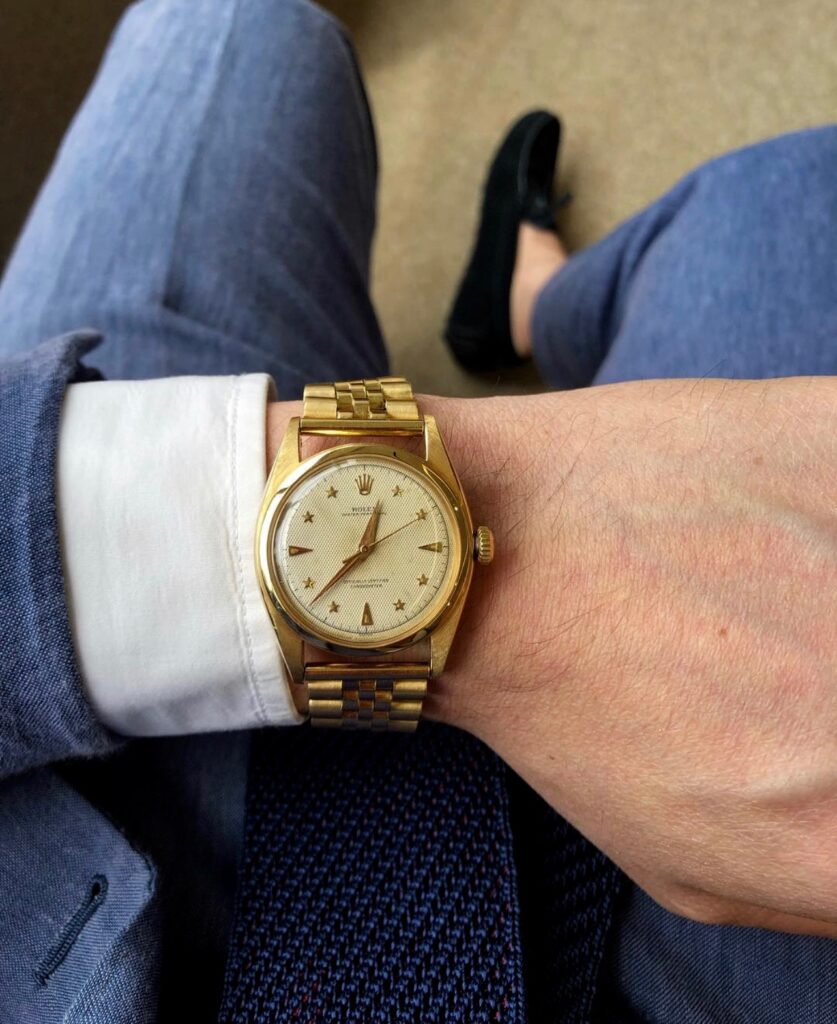
(Credit: MT, Singapore).
My favourite star dial remains the Galaxy or Ref 6088, with the very rare black star dial.
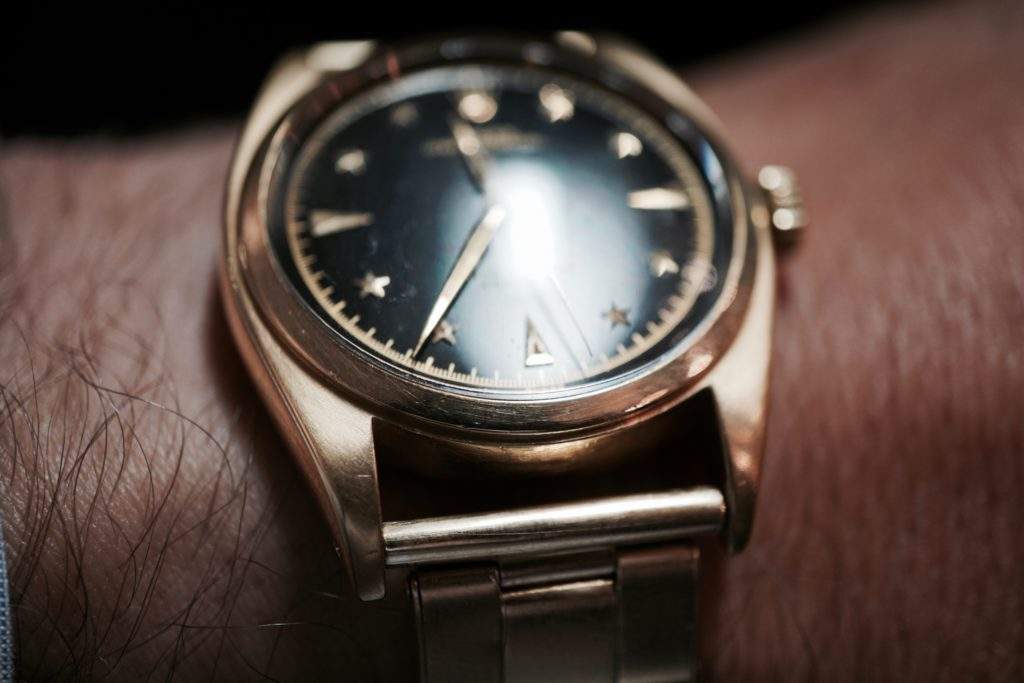
The ref 6565 semi-large bubble-back is with black lacquer dial and unusual hour markers with lume.
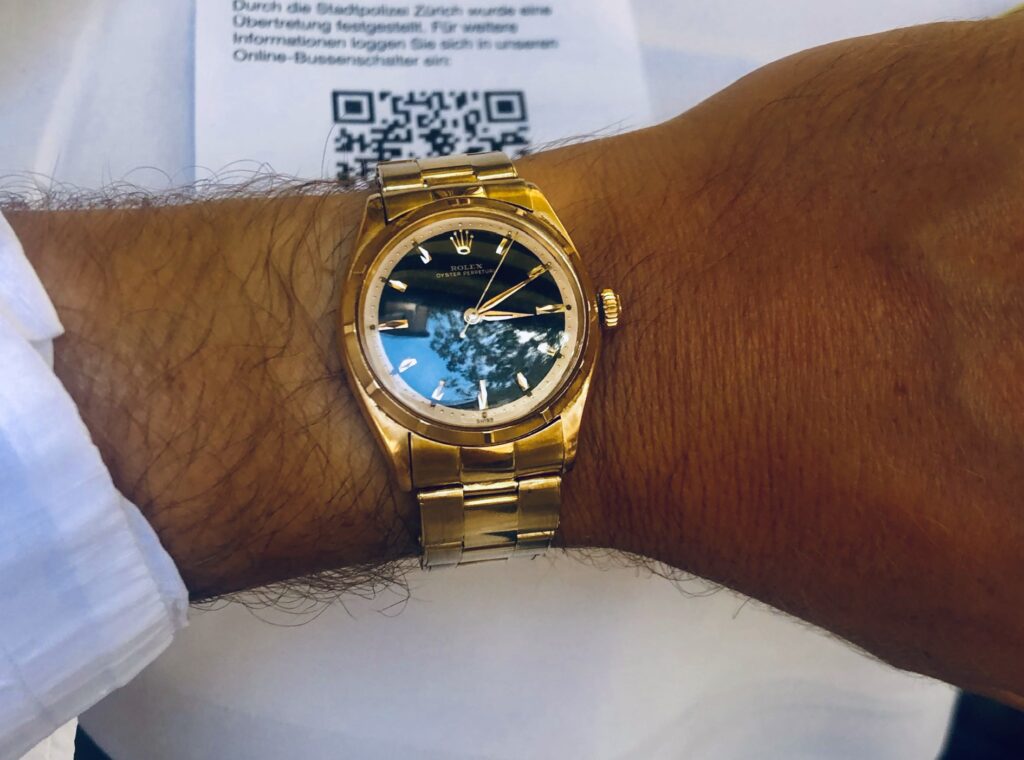
(Credit: mfc.vintagewatches).
Just because this watch is so unusual and rare. A ref 6285 belonging to a private collector based near Parma.
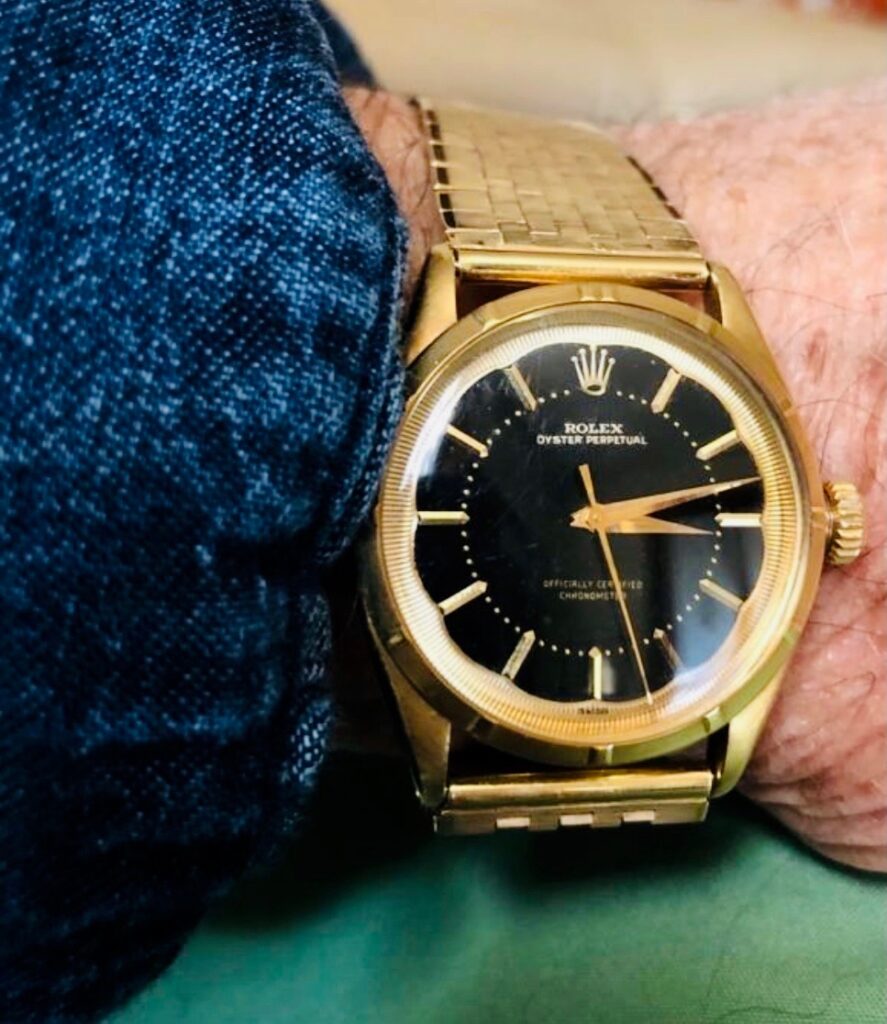
We move on to the single color Enamel dials time only Rolex. First, a splendid ref 6090 with blue Enamel – similar to the one that sold at Phillips.
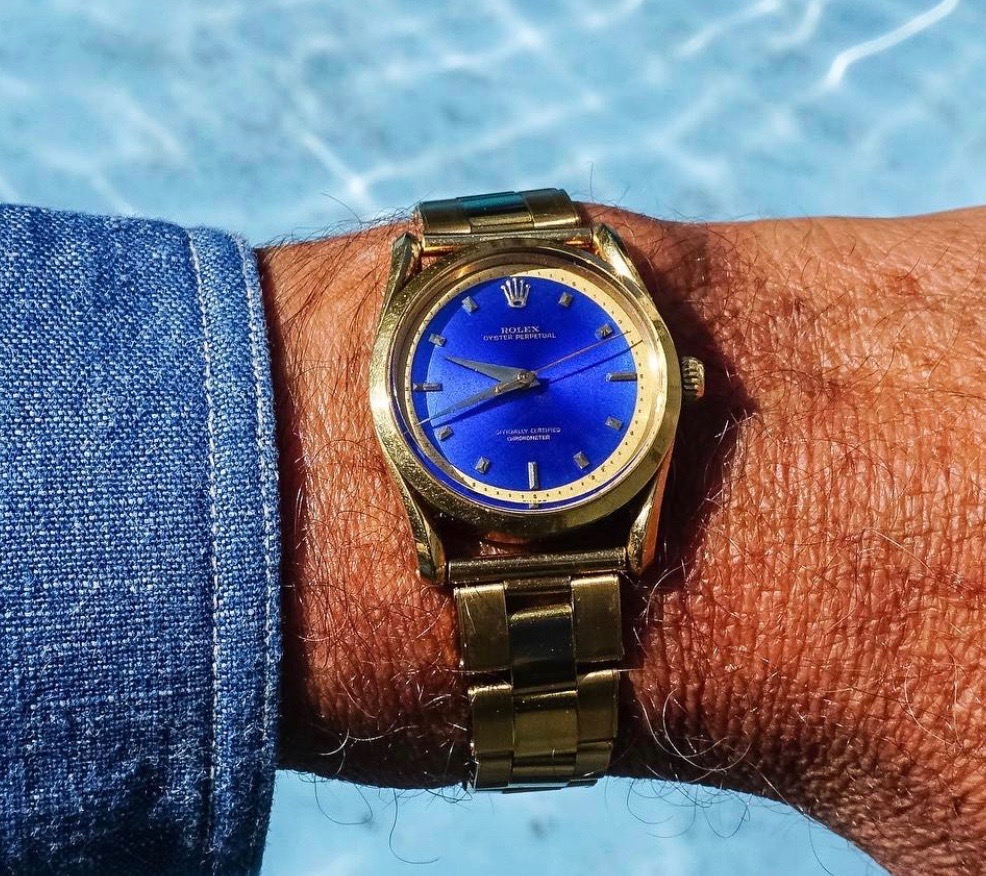
(Credit: Goldberger).
Last but not least an extremely rare Rolex ref 6018 in tobacco brown. Notice the bombe style case found often in the 6090.
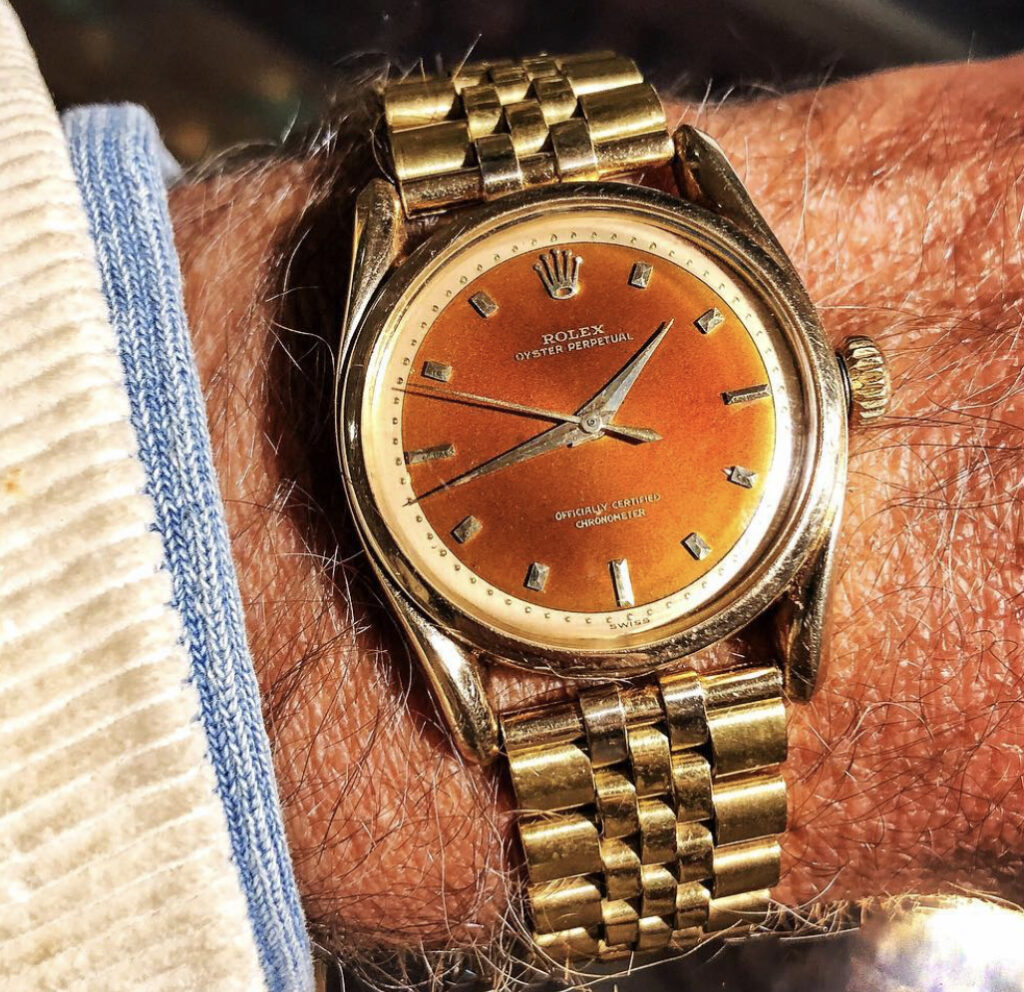
(Credit: Goldberger).
